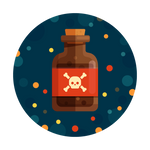
Dioxins and Furans: Toxic Chemicals Explained
Our blog is written by real experts— not AI. Each guide is carefully reviewed and updated based on the latest research. Plus, with no affiliate links, you can count on unbiased insights you can trust.
The list of unintended consequences from industrial activity is long and complex. An important member of this list is the release of chemical byproducts into the environment. Read below to learn about the sources, exposures, and harmful health effects of the toxic industrial byproducts called dioxins and furans.
What Are Dioxins and Furans?
Dioxins and furans are the common names for two related families of environmentally persistent, toxic substances. Dioxins and furans have similar structures, or basic chemical “skeletons”, and they all include chlorine atoms. These chemicals are not produced intentionally, but often form during the production of other chemicals and consumer products, fuel and waste-burning, and natural disasters.[1]
Let's look at the structures of dioxins and furans. At the most basic level, we find p-dioxin and furan. More complex dioxin and furan compounds include these basic structures.

Furan and p-dioxin are nontoxic on their own, but when two benzene rings and multiple chlorine atoms get added, it produces the harmful compounds that public health and environmental agencies like the EPA are concerned about. The dioxins and furans in these groups are called polychlorinated dibenzo-p-dioxins (PCDDs) and polychlorinated dibenzofurans (PCDFs).[8]


How Do Dioxins and Furans Get Into Drinking Water?
Dioxins and furans have become widespread at very low levels in the environment and drinking water sources, primarily due to human activity. Sources of dioxins and furans include release during the large-scale burning of garbage and medical waste, iron, steel, paper, and chemical production, fuel and wood burning, and generating electrical power. Releases from natural sources, for example forest fires (which are often also caused by human activity) and volcanic eruptions, are smaller contributors.[4] There have been rare cases of severe dioxin and furan contamination incidents related to industrial releases.[5]
Dioxins and furans can settle from the air into water sources when it rains or snows, or through wastewater contamination; however, these compounds are seldom found in drinking water due to their low solubility.[9] Dioxins can exist at high levels in stores of industrial oil waste. When this waste is disposed of, it can cause significant environmental contamination, including in drinking water sources.[10]
Once dioxins and furans enter the environment, it takes a long time for them to break down. Dioxins and furans can travel long distances in the atmosphere. Though the release of dioxins and furans is local, the environmental distribution from these sites is global due to their persistence and mobility.[5]
How Can I Be Exposed?
Dioxins and furans are widespread in the air, water, and soil, so all people have some background exposure. The most significant route of exposure occurs via high-fat foods, including milk products, eggs, meat, and certain types of fish. This is due to their ability to build up in the fatty tissues of beef, pork, poultry, and other animals.[4] Furans have also been found in certain canned goods (soups, sauces, beans, and baby food).[3]
Individuals who burn municipal waste or their own garbage or work with metal smelters and power plants are at higher risk of exposure. Elevated drinking water exposures are unlikely for most people.[6]
What Are the Health Effects of Dioxins and Furans?
Research into the health effects of long-term, low levels of dioxins and furans, like one might find in drinking water, is rapidly evolving. Studies performed on animal models suggest a possible association between these chemicals and multiple types of cancer, changes to fetal development, and endocrine, immune, and reproductive problems.[6]
Research suggests that the location of chlorine atoms impacts the toxicity of PCDDs and PCDFs. Trends show that the more chlorine atoms on the outside of the molecule, the greater its toxicity. These outer chlorines help the molecules bind to aryl hydrocarbon receptors, which normally protect the body against harmful compounds, and cause the body to express harmful genes.[8]
For example, the chemical 2,3,7,8 Tetrachlorodibenzo-p-dioxin (TCDD) is considered the most toxic of the dioxins and furans. Note that the chlorines on this compound are located on either side of the molecule.

The EPA has developed an enforceable drinking water standard (a maximum contaminant level or MCL) for TCDD. The MCL is set based on evidence from animal studies that found male reproductive toxicity and increased cancer risk associated with the compound. [7] The International Agency for Research on Cancer also classifies 2,3,7,8-TCDD as a known human carcinogen at elevated levels.[5]
Certain PCDFs and PCDDs have the potential to cause damage to a variety of organ systems when found in drinking water. Most of the information we have is based on the effects seen in exposed animals, so additional research is needed to assess the true extent to which dioxins and furans will harm human health.
Check Your Water for PCDFs and PCDDs
Dioxins and Furans Water Test
Test your drinking water for dioxins and furans–which can form during industrial and manufacturing processes, waste-burning, and natural disasters.
Dioxin (TCDD) Water Test
Test your drinking water for dioxin (TCDD), an industrial chemical related to waste incineration and other industrial activity.
If you have any concerns about dioxins and furans in your water from nearby industry or a known spill, you can test your water with the specialized test packages listed above.
Always feel free to reach out to our team of water quality engineers, treatment experts, and chemists who are standing by to help figure out your next steps and answer any questions you may have about your water.
Send them a message any time: support@mytapscore.com
Read More
▾Sources and References
▾- Dioxins, Furans and Dioxin-Like Polychlorinated Biphenyls Factsheet | National Biomonitoring Program | CDC
- 2-3-7-8-tetrachlorodibenzo-p-dioxin.pdf (epa.gov)
- Questions and Answers on the Occurrence of Furan in Food | FDA
- Dioxins and Furans - Canada.ca
- Dioxins and their effects on human health (who.int)
- Dioxins and Furans Fact Sheet | US EPA ARCHIVE DOCUMENT
- National Primary Drinking Water Regulations | US EPA
- Dioxins and dioxin-like compounds - Wikipedia
- Chlorodibenzofurans (CDFs) - ToxFAQs (cdc.gov)
- Chlorinated Dibenzo-p-Dioxins ToxFAQ (cdc.gov)








